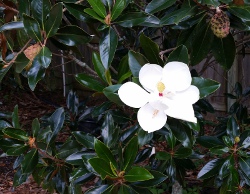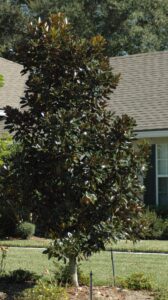S & J Nursery’s Guide to Growing
Little Gem Magnolia
in the Northeast Florida Landscape
( Magnolia grandiflora ‘ Little Gem’ )
Origins of the Little Gem Magnolia:
– A selection of the North American Native Magnolia Grandiflora bred for its small
leaves, year round bloom and small mature size.
Preferred Exposure for Little Gem Magnolia / Magnolia Grandiflora ‘Little Gem’:
– Full sun to partial sun /shade situations are tolerated in the North Florida | Jacksonville | St. Augustine area landscape.
Foliage of the Little Gem Magnolia / Magnolia Grandiflora ‘Little Gem’ :
– Little Gem remains evergreen keeping its foliage in the winter season and is smaller than that of a typical Magnolia Grandiflora growing 4-8 inches in length.
– Foliage of the the Little Gem Magnolia tree is a deep dark glossy green on the upper side of the leaf and a soft fuzzy reddish brown to tan color on the underside of the leaf.
Magnolia Little Gem Soil Preference / Salt tolerance:
– Magnolia Little Gem will prefer slightly acidic soil but will tolerate sand, loam, clay, slightly alkaline and even occasionally wet
soils.
– Only moderately salt tolerant, not for direct coastal exposure
plantings
 Little Gem Magnolia / Magnolia Grandiflora ‘Little Gem’ Size Variance:
Little Gem Magnolia / Magnolia Grandiflora ‘Little Gem’ Size Variance:
– Magnolia Little Gem has been touted as a dwarf magnolia selection since it’s introduction, and indeed it is MUCH smaller than what is typically found in Magnolia Grandiflora. The problem comes in that when they were introduced they were said to reach height s of 12-15 ft and you will still find
ALOT of literature that shows that growth range for the Little Gem Magnolia. However it is now thought to be able to grow double the size of its predicted mature height and has actually been found to be
capable of growing closer to 30-35 ft in height and 8-12 ft wide.
Magnolia Little Gem Growth Habit:
– Little Gem Magnolia has a narrow oval to pyramidal habit and tends to be much higher than it is wide.
Growth Rate:
– Little Gem Magnolia trees are slow to moderate growers.
Blooms on the Little Gem Magnolia:
– These trees have a large and highly fragrant creamy white leathery blooms that reach 6-10 inches across with a central cone that will enlarge and open up after the petals have gone to expose beautiful bright red seeds that are utilized by various wildlife in the North Florida | Jacksonville |
St. Augustine area landscapes and gardens.
– Little Gems tend to bloom much longer than other magnolias having blooms in spring and intermittently throughout the year.
Little Gem Magnolia Water Requirements:
– Magnolia grandiflora trees need daily water after being planted from a
container or transplanted into the landscape and supplemental irrigation during periods of reduced local rainfall for the first season or two.
Butterfly or Bird Attracting:
– Magnolias thickly foliated branches make ideal nesting sites for Northeast Florida birds. Blooms are followed by a fuzzy tan to brown central seed cone that matures in the fall opening up to expose beautiful bright glossy red coated seeds that are utilized by local wildlife.
Best Uses For Little Gem Magnolia in the Northeast Florida | Jacksonville | St. Augustine Landscape:
Northeast Florida | Jacksonville | St. Augustine Landscape:
– Southern Magnolia ‘Little Gem’ is an ideal selection for a smaller space area where a broader spreading Southern Magnolia selection might be out of place.
– Little Gem Magnolia trees will supply excellent coverage to screen large unwanted views and will remain evergreen in the winter time and have the added bonus of the large fragrant blooms.
– Use Little Gem for house foundation plantings where you wan ta striking accent tree to attract interest to your landscape.
– Southern Magnolias also make excellent street trees.
Care of Little Gem Magnolia for the Northeast Florida Jacksonville | St. Augustine area Landscape:
– Although Magnolia trees can be planted from a container into the landscape any time of the year in our North Florida | Jacksonville | St. Augustine area landscapes, Magnolias root systems
are very wide for their size making transplanting sometimes difficult, so if you decide to move one from one location to another in the yard be sure to do it in winter or spring for the best result possible.
– Water every day during the establishment period, See watering your newly planted trees for more information. Magnolia’s must be
watched for the first one to two seasons after being planted
or transplanted in the landscape and supplemental water supplied in any time of drought. They are slower to establish themselves into
the landscape than many other trees and should be watered well once a week when local rainfall is scarce.
– Magnolias respond well to pruning, when shaping a younger tree
they should be pruned 6 inches deeper than where you would like to see the re-growth appear. Everywhere you trim the tree will sprout new growth and begin to branch out and fill in. So if you have a scarcely foliated Magnolia tree get out the pruners and remove as many growing tips as possible, prune deeper into the branch in
scarcely foliated areas to get them to branch out and fill in the gaps.
– Magnolias have lots of branches that will be smaller in diameter in comparison to other larger growing shade trees like an Oak. Prune out the occasional occurrence of a branch at a sharper angle than 45 degrees or if damaged etc. by removing the branch all the way back to the trunk.
– Provide a 1 ft diameter circle of mulched area where grass is kept from growing for each inch of caliper (or diameter) of trunk measured 4 inches from the ground level.
– Fertilize each spring with a mixture of Milorganite and a slow release poly coated plant food such as Osmocote or Stay Green general purpose plant food, sprinkling the fertilizer around the mulch circle underneath the foliage of the tree.

